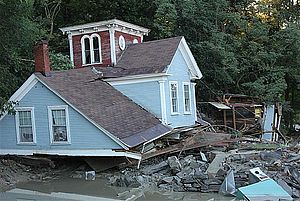Tropical Storm Irene: How Do We Prepare for the Next One? Second in a two-part series

Photo by USFWS.
By Lake Champlain Committee Staff Scientist Mike Winslow
Under any scenario events like Tropical Storm Irene and the spring floods of 2011 will be extreme outliers; however, climate models do predict we should expect and prepare for more intense storms in the years to come. Regional models produced by the Union of Concerned Scientists predict rainfall will become more intense and that periods of heavy rainfall will become more frequent in the Northeast. A climate change analysis done by The Nature Conservancy documents that the frequency of storm events depositing more than two inches of precipitation within 48 hours has already doubled between the mid-1900s and today.
Some preparations for increased storminess include building roads and stormwater structures that can withstand increased flows, designating funds for maintaining stormwater systems over time, flood-proofing important public buildings near waterways, and developing zoning regulations that discourage or prevent new construction in floodplains.
New developments can be created and designed so that more storm water filters into the soil and less runs offsite. Strategic improvements can be made in planning developments to preserve wet areas and direct runoff from houses, roads and driveways into those areas. More trees can be left on site to intercept rainwater and whisk water from the soil to the air. In many cases surfaces that traditionally shed water can be re-engineered to absorb it. Rooftops can become gardens. Driveways and sidewalks can be made from materials that allow water to soak through rather than pool on top. Cumulatively, these practices are often referred to as Low Impact Design or LID.
Culverts are a vulnerable point in any flooding event. Throughout the Champlain Valley many culverts, used underneath roads at small stream crossings, are too small for the amount of water they must carry. The reason is simple: larger culverts are more expensive. However smaller culverts become choke-points during flooding events, vulnerable to erosion and creating upstream flooding. As a result, smaller culverts simply need to be replaced more often because they wash out, and they can increase the risk of property damage. Furthermore, undersized culverts often end up hanging above the stream, creating an impediment to the up-stream passage of fish and other wildlife. Long-term accounting therefore favors larger culverts for both environmental and economic reasons.
One potential guideline for local communities seeking to prepare for more intense rains would be to voluntarily adopt relevant elements of the Environmental Protection Agency’s stormwater regulations (often referred to as the Phase II rule). These regulations, mandatory in larger communities, call for six minimum measures: identifying and eliminating illicit discharges, involving and educating the public about stormwater, developing plans for managing stormwater from municipal facilities, and developing ordinances to reduce stormwater pollution during and after construction activities.
Protection of critical land areas can help minimize flood damage. Streams overflow their banks in predictable areas where the slope decreases. Permanently protecting these riparian zones with conservation easements or outright purchase is an important tool for minimizing future flood risk. Wetlands also serve as an important role in reducing flooding. Vermont’s Otter Creek caused tremendous damage in Brandon and Rutland, but downstream communities like Middlebury and Vergennes were largely spared. One reason is that between Brandon and Middlebury there is a large complex of wetlands that absorbed the floodwaters and released them slowly over time. Compared to upstream, peak downstream river levels were not as abnormally high, were slower to arrive, and were slower to recede.
When it comes to rebuilding after Tropical Storm Irene, we must not let our fear of future disasters replace all the wisdom we have gathered since the massive floods of 1927 about how rivers interact with their landscape. The events associated with Irene were intense and devastating. Damage from flooding occurs when rivers lash out against our historic attempts to confine them in narrow channels. Any attempt to control nature, to prevent flooding from ever happening again, will inevitably fail. Instead we must use what we have learned about rivers over the past century to rebuild in a way that accommodates rivers and allows them access to their floodplain. As Vermont House Speaker Shap Smith said when speaking of damaged roads and buildings, “We have to be thoughtful how we rebuild to avoid repeat problems.”
Click for Tropical Storm Irene: How Do We Respond? First in a two-part series
